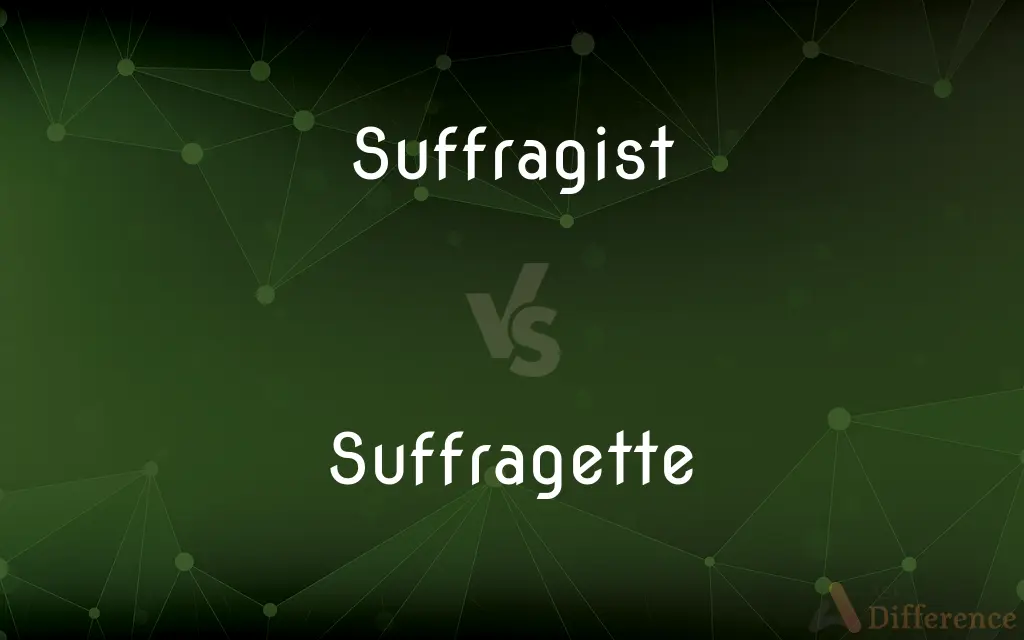Suffragist vs. Suffragette — What's the Difference?
By Fiza Rafique & Urooj Arif — Updated on March 28, 2024
Suffragists were advocates for women's voting rights using peaceful methods, whereas suffragettes used more militant tactics to achieve the same goal.

Difference Between Suffragist and Suffragette
Table of Contents
ADVERTISEMENT
Key Differences
Suffragists campaigned for women's voting rights through peaceful and lawful means, emphasizing rational argument and persuasion. They believed in working within the system to enact change, lobbying politicians, and raising public awareness through speeches and publications. On the other hand, suffragettes adopted more militant tactics, including public demonstrations, hunger strikes, and sometimes even vandalism. They argued that dramatic actions were necessary to draw attention to their cause and force changes in the law.
While suffragists often formed broad-based organizations that sought to attract widespread support across different social classes, suffragettes typically operated through smaller, more tightly-knit groups that were willing to take greater risks for their cause. Whereas suffragists preferred to engage in dialogue and advocacy, suffragettes were prepared to confront the authorities directly.
The suffragist movement was characterized by its emphasis on inclusivity and its appeal to both men and women to support the cause of women's suffrage. In contrast, the suffragette movement, especially in its early days, sometimes focused more on the actions of women themselves as the primary agents of change, under the belief that women had to take a stand for their own rights.
Suffragists and suffragettes shared the ultimate goal of securing women's right to vote, but their strategies and philosophies reflected different approaches to political activism. While suffragists sought to build consensus and work within existing political frameworks, suffragettes believed in challenging the status quo more aggressively.
Despite their differences, both suffragists and suffragettes contributed significantly to the women's suffrage movement. Their efforts, though varied in method, were crucial in achieving the shared objective of granting women the right to vote, illustrating the diversity of tactics necessary in social movements.
ADVERTISEMENT
Comparison Chart
Definition
Advocates for women's voting rights through peaceful means.
Advocates for women's voting rights through militant tactics.
Methods
Peaceful lobbying, speeches, publications.
Public demonstrations, hunger strikes, vandalism.
Organizational Structure
Broad-based, inclusive.
Smaller, tightly-knit groups.
Appeal
To both men and women, across social classes.
Primarily to women as the agents of change.
Philosophy
Working within the system to enact change.
Challenging the status quo aggressively.
Compare with Definitions
Suffragist
An individual advocating for women's voting rights through nonviolent means.
The suffragist organized a petition to present to the local legislature.
Suffragette
Emphasized the role of women in actively fighting for their own rights.
Suffragettes encouraged women to take bold actions to demand their voting rights.
Suffragist
Focused on inclusivity and consensus-building.
The suffragist collaborated with other civil rights groups to build a more inclusive movement.
Suffragette
Employed dramatic and sometimes illegal actions to draw attention.
Suffragettes organized a march that culminated in a sit-in at the mayor's office.
Suffragist
Aimed to garner support from a wide demographic, including men.
The suffragist movement held a rally that was attended by a diverse group of people from various backgrounds.
Suffragette
Focused on aggressively challenging existing power structures.
By smashing windows and staging hunger strikes, suffragettes showed their willingness to confront injustice head-on.
Suffragist
They engaged in lobbying, giving speeches, and writing to promote their cause.
A suffragist gave a compelling speech at the town hall about the importance of women's voting rights.
Suffragette
An activist advocating for women's voting rights through direct action and militant tactics.
The suffragette was arrested during a protest for chaining herself to the gates of Parliament.
Suffragist
Utilized logical and reasoned arguments to persuade others.
In her writings, the suffragist laid out clear, logical reasons why women should have the right to vote.
Suffragette
Operated within close-knit, often secretive organizations.
The suffragette group planned their next action in a covert meeting.
Suffragist
An advocate of the extension of political voting rights, especially to women.
Suffragette
A suffragette was a member of an activist women's organisation in the early 20th century who, under the banner "Votes for Women", fought for the right to vote in public elections in the United Kingdom. The term refers in particular to members of the British Women's Social and Political Union (WSPU), a women-only movement founded in 1903 by Emmeline Pankhurst, which engaged in direct action and civil disobedience.
Suffragist
A person who promotes suffrage.
Suffragette
An advocate of women's suffrage, especially in the United Kingdom.
Suffragist
One who votes.
Suffragette
(historical) A female supporter, often militant, of women's right to vote in the early 20th century, especially in Great Britain.
Suffragist
One who possesses or exercises the political right of suffrage; a voter.
Suffragette
A woman who advocates the right to vote for women; a woman suffragist.
Suffragist
One who has certain opinions or desires about the political right of suffrage; as, a woman suffragist.
It is curious that . . . Louisa Castelefort should be obliged after her marriage immediately to open her doors and turn ultra liberal, or an universal suffragist.
Suffragette
A woman advocate of women's right to vote (especially a militant advocate in the United Kingdom at the beginning of the 20th century)
Suffragist
An advocate of the extension of voting rights (especially to women)
Common Curiosities
Which came first, the suffragist or the suffragette movement?
The suffragist movement began earlier, with suffragettes emerging later as a more militant branch.
How did public opinion view suffragettes?
Public opinion was divided, with some admiring their courage and others condemning their tactics as too radical.
What did suffragists believe in?
Suffragists believed in achieving women's voting rights through peaceful, lawful advocacy and persuasion.
Can men be considered suffragists?
Yes, men who supported women's voting rights can also be considered suffragists.
What tactics did suffragettes use?
Suffragettes used militant tactics, including protests, hunger strikes, and sometimes vandalism, to fight for women's voting rights.
Were suffragists and suffragettes part of the same movement?
Yes, both were part of the broader women's suffrage movement but differed in their methods and strategies.
Did suffragists support the actions of suffragettes?
Suffragists often disagreed with the militant tactics of suffragettes, preferring peaceful advocacy.
How did the suffragette movement end?
The suffragette movement largely dissolved after achieving its main goal of women's suffrage, though many activists continued to fight for gender equality.
Did suffragist and suffragette movements exist outside of the UK and US?
Yes, similar movements existed globally, with local variations in tactics and emphasis.
Did suffragettes only fight for the vote?
While their main focus was on women's voting rights, suffragettes also highlighted broader issues of gender inequality.
What is the legacy of the suffragists and suffragettes today?
Their legacy is a testament to the importance of both peaceful advocacy and direct action in social movements.
Were there any famous suffragists or suffragettes?
Yes, notable suffragists include Susan B. Anthony, while Emmeline Pankhurst was a prominent suffragette.
Did the suffragist and suffragette movements succeed?
Both movements were instrumental in achieving women's suffrage in various countries throughout the early 20th century.
Share Your Discovery

Previous Comparison
Gate vs. Stargate
Next Comparison
Asmodeus vs. BelialAuthor Spotlight
Written by
Fiza RafiqueFiza Rafique is a skilled content writer at AskDifference.com, where she meticulously refines and enhances written pieces. Drawing from her vast editorial expertise, Fiza ensures clarity, accuracy, and precision in every article. Passionate about language, she continually seeks to elevate the quality of content for readers worldwide.
Co-written by
Urooj ArifUrooj is a skilled content writer at Ask Difference, known for her exceptional ability to simplify complex topics into engaging and informative content. With a passion for research and a flair for clear, concise writing, she consistently delivers articles that resonate with our diverse audience.














































